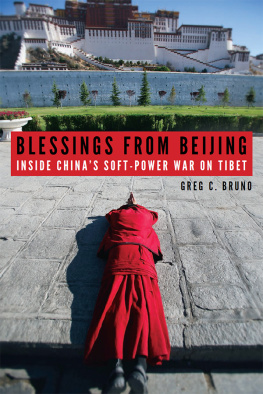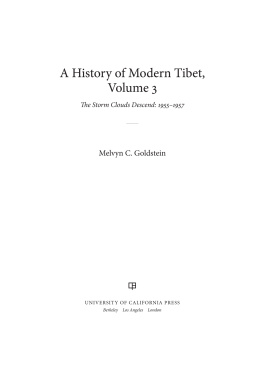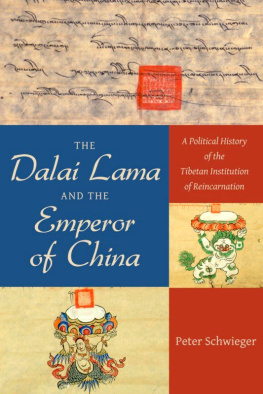WHEN THE IRON BIRD FLIES
Chinas Secret War in Tibet
JIANGLIN LI
Translated by Stacy Mosher With a Foreword by the Dalai Lama
STANFORD UNIVERSITY PRESS
Stanford, California
STANFORD UNIVERSITY PRESS
Stanford, California
English translation 2022 by the Board of Trustees of the Leland Stanford Junior University.
All rights reserved.
A previous version was published in Chinese under the title Dang tieniao zai tiankong feixiang: 1956 1962 qingzang gaoyuan shang de mimi zhanzheng 2012 by Lianjing chuban gongsi.
Preface 2022 by the Board of Trustees of the Leland Stanford Junior University.
All rights reserved.
No part of this book may be reproduced or transmitted in any form or by any means, electronic or mechanical, including photocopying and recording, or in any information storage or retrieval system without the prior written permission of Stanford University Press.
Printed in the United States of America on acid-free, archival-quality paper
Library of Congress Cataloging-in-Publication Data
Names: Li, Jianglin, 1956 author. | Mosher, Stacy, translator.
Title: When the iron bird flies : Chinas secret war in Tibet / Jianglin Li; translated by Stacy Mosher.
Other titles: Dang tie niao zai tian kong fei xiang. English
Description: Stanford, California : Stanford University Press, [2022] | A previous version was published in Chinese under the title Dang tieniao zai tiankong feixiang: 1956 1962 qingzang gaoyuan shang de mimi zhanzheng 2012 by Lianjing chuban gongsi. | Includes bibliographical references and index.
Identifiers: LCCN 2021026174 (print) | LCCN 2021026175 (ebook) | ISBN 9781503615090 (cloth) | ISBN 9781503629790 (epub)
Subjects: LCSH: Tibet Autonomous Region (China)History1951 | Tibet Autonomous Region (China)HistoryUprising of 1959. | ChinaRelationsChinaTibet Autonomous Region. | Tibet Autonomous Region (China)RelationsChina.
Classification: LCC DS786 .L4619313 2022 (print) | LCC DS786 (ebook) | DDC 951/.505dc23
LC record available at https://lccn.loc.gov/2021026174
LC ebook record available at https://lccn.loc.gov/2021026175
Cover design: Rob Ehle
Cover photo: Ian Dikhtiar | Dreamstime.com
Text design: Kevin Barrett Kane
Typeset at Stanford University Press in 11.5/15 Arno Pro
When the iron bird flies,
And horses run on wheels,
The Tibetan people will be scattered like ants across the world,
And the Dharma will come to the land of the Red Man
Prediction attributed to Padmasambhava, 8th century
CONTENTS
by His Holiness the Dalai Lama
FOREWORD
By His Holiness the Dalai Lama
In her 2010 book entitled Tibet in Agony: Lhasa 1959, the Chinese historian Li Jianglin presented conclusive research on the Tibetan popular uprising, the circumstances that led me to leave Lhasa for exile in India, the emergency situation in Tibet at that time, the attitudes of senior Chinese leaders, and so on. Presenting an honest and detailed account of the situation at that time, and informing historians in China especially, and the general reader, about the real situation, it was most beneficial.
Here, in Li Jianglins second book, Chinas Secret War in Tibet, we have for the first time a Chinese historian presenting conclusive research on Tibets recent history and the facts about Chinas military suppression of Tibet in the 1950s, in an unbiased and genuine manner. She has consulted a great many books and documents, public, private, and secret, as well as interviewing many persons involved in that history, in order to clarify many things about the events of that time. As I always say, Chinas 1.3 billion people have a right to know what really happened, and I believe that if they could get an understanding of the real situation, they would be able to distinguish good from bad and truth from falsehood, and it is my hope that through this historical documentation establishing the truth of what happened, Chinese intellectuals, and all other readers, will come to understand the real situation and be able to deepen their approach to and understanding of the Tibet problem in the spirit of seeking truth from facts.
With my praise and admiration for the author on the fruition of her many labors.
The Dalai Lama
Tibetan Royal Year 2139
Water Dragon
March 30, 2012
PREFACE TO THE ENGLISH EDITION
While I was researching the March 1959 Lhasa incident, in the years from 1956 to 1962.
A large amount of written material shows that intense military conflicts occurred in Chinas southwestern and northwestern regions from the mid-1950s through the early 1960s, covering all three of the traditional Tibetan provinces, which today are known as the Tibet Autonomous Region (TAR) and the Tibetan prefectures of the four peripheral provinces. On one side of the conflict were the Chinese Peoples Liberation Army (PLA) Field Armies and regional units with their modern weaponry, as well as trained militia; on the other side were Tibetan farmers, herders, and monks, along with a handful of government officials and some Tibetan soldiers, armed mainly with homemade muskets, rifles, knives, and spears. This military conflict lasted six and a half years, from the early spring of 1956 through the summer of 1962. Of the PLAs twelve military commands at that time, seven participated in this conflict to varying drawing on infantry, artillery, cavalry, air force, armored and motor vehicle, and anti-chemical divisions, among others.
This was a military operation under the unified command of the Central Military Commission (CMC) and the leadership of local party committees, Nicknamed the Bull, this type of aircraft was a Soviet-made long-range heavy bomber, the most advanced that the Chinese military owned at that time.
The total number of Tibetan casualties in this 6-year campaign may never be made known to the public. In 1961, the CCP held a Northwest Ethnic Minorities Work Conference, which partially redressed the over-amplified pacification of the rebellion in Qinghai and Gansu provinces, but what has been made public up to now omits key information. but the specifics remain classified to this day, and the information recorded in local gazetteers is confusing and incomplete. In short, after more than half a century, this military conflict remains a closely held secret.
After the Chinese edition of my book Tibet in Agony: Lhasa 1959 was published, in 2010, I immediately began researching this broader military conflict and its background, process, and aftermath.
For readers who may not have in-depth knowledge of the history of modern Tibet, I would like to provide a brief geographic and historical background.
First, regarding the definition of Tibet: The Chinese term Xizang has a specific meaning in Chinas modern history, and is not equivalent to the traditional three Tibetan regions. Geographically, traditional Tibet included the three regions of -Tsang and Ngari (Weizang Ali, central Tibet, and western Tibet), Kham (Kang, eastern Tibet), and Amdo (Anduo, northeastern Tibet), together covering approximately one fourth of todays China, while Xizang refers to central Tibet, which is more or less the area of todays Tibet Autonomous Region (TAR).
Traditional Tibet had internal differences, not only in geography and customs but also in politics and administration. In his book Tibet: Past and Present (1924), the British diplomat Sir Charles Alfred Bell (18701945) elaborates this point. He refers to the regions where Tibetans live as ethnographic Tibet and calls the realm of the Lhasa government political Tibet. He adds, While attempting to define the former, let us not neglect the latter.







